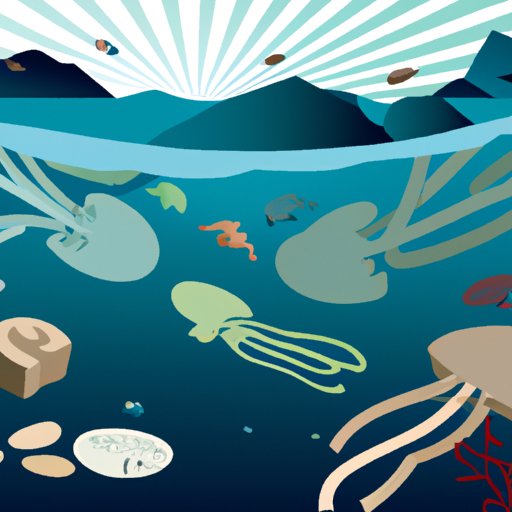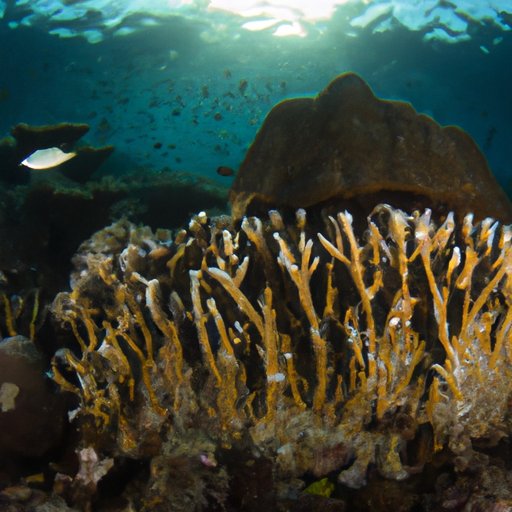Introduction
What is coral, and why is it so important to understand these delicate ecosystems? In this guide, we will delve into the world of coral and explore its anatomy, life cycle, and adaptations. We will also discuss the critical role that coral reefs play in the larger ecosystem and their benefits to humans. Finally, we will examine the threats facing coral reefs today, as well as the efforts being made to protect and restore these crucial environments.
Exploring the Intricate World of Coral: A Comprehensive Guide
What is coral?
Coral are colonies of small animals known as polyps that secrete calcium carbonate to form protective exoskeletons. These exoskeletons serve as the structural base for the coral colony to grow. Coral come in a variety of shapes, sizes, and colors and can form complex structures known as coral reefs.
Anatomy of coral
Coral polyps are small, typically no larger than a few millimeters. They have a simple body structure, with tentacles that surround a central mouth. These tentacles contain tiny stinging cells known as nematocysts, which the polyps use to capture food.
Types of coral
There are hundreds of species of coral, with a wide range of shapes, sizes, and colors. Some common types of coral include hard corals, soft corals, and black corals. Hard corals are the reef builders, and they are the ones that secrete the calcium carbonate that forms the reef’s structure. Soft corals, on the other hand, do not secrete calcium carbonate and are generally more flexible than hard corals. Black corals have a distinctive black or dark brown appearance and are found in deeper waters.
Life cycle of coral
Coral undergo a complex life cycle that involves both sexual and asexual reproduction. Sexual reproduction involves the release of eggs and sperm into the water, where they combine to form a new coral polyp. Asexual reproduction occurs via budding, where a new polyp grows from the parent polyp. Over time, these individual polyps combine to form colonies, which can grow to become massive reefs.
Beyond the Reef: Why Coral is Essential to the Ocean and Our World
Coral’s role in the ecosystem
Coral reefs are often referred to as the “rainforests of the sea,” due to their incredible diversity and productivity. They provide vital habitat for millions of fish and other marine species, including many commercially important ones. They also help to protect shorelines from storms and erosion, and they play a crucial role in nutrient cycling and carbon sequestration.
Benefits of coral to humans
Coral reefs provide numerous benefits to humans, including food, tourism, and pharmaceuticals. Many coastal communities rely on reefs for their livelihoods, with fishing and tourism both major industries. Additionally, coral is a source of compounds with potential medicinal uses, including anti-cancer and anti-inflammatory drugs.
Threats to coral reefs
Coral reefs are currently facing a range of threats, including climate change, pollution, overfishing, and destructive fishing practices. Climate change is perhaps the most significant threat, as rising temperatures and increasing ocean acidity are putting stress on these delicate ecosystems.
The Mysteries of Coral Uncovered: An Introductory Overview
History of coral
Corals have existed for millions of years, with fossil evidence indicating that they first appeared over 500 million years ago. Over time, they have evolved to become some of the most complex and diverse organisms on the planet.
Coral’s symbiotic relationships
Coral polyps have a unique symbiotic relationship with algae known as zooxanthellae. These algae live within the polyp’s tissues and provide them with energy through photosynthesis. In return, the polyps provide the algae with shelter and nutrients.
Adaptations of coral
To survive in their often-harsh environments, coral have evolved a range of adaptations. For example, they can produce toxins to defend against predators, and they can release their eggs and sperm in synchrony to increase their chances of successful reproduction.

The Impact of Climate Change on Coral Ecosystems and How We Can Help
The effects of climate change on coral
Climate change is having a significant impact on coral reefs, with rising temperatures and increasing ocean acidity causing widespread coral bleaching and death. This is leading to the loss of vital habitat for fish and other marine species, as well as the loss of important ecosystem services.
Prevention and mitigation of climate change
To mitigate the effects of climate change on coral reefs, it is essential to reduce greenhouse gas emissions and transition to a low-carbon economy. This requires a collective effort from governments, businesses, and individuals to reduce our carbon footprint and promote sustainable practices.
Restoration efforts
In addition to reducing carbon emissions, there are also efforts underway to restore damaged coral reefs. These efforts can include transplanting corals from healthy reefs, removing debris and pollutants from degraded areas, and promoting natural regeneration through sustainable fishing practices and marine protected areas.
A Visual Tour of Some of the Most Beautiful Coral Reefs in the World
Description of various coral reefs
From the Great Barrier Reef in Australia to the Coral Triangle in Southeast Asia, there are numerous beautiful and diverse coral reefs around the world. Each has its unique ecosystems and species, and each is a vital part of the larger marine environment.
Importance of protecting and preserving these reefs
Given the critical role that coral reefs play in our world, it is essential to protect and preserve them for future generations. This can be achieved through a combination of measures, including sustainable fishing practices, pollution prevention, and the establishment of marine protected areas.
Coral Conservation: The Key Players and How You Can Get Involved
Organizations dedicated to coral conservation
There are numerous organizations around the world dedicated to coral conservation, including the Coral Reef Alliance, the Nature Conservancy, and the World Wildlife Fund. These organizations work on a range of initiatives, from research and monitoring to restoration and policy advocacy.
Ways individuals can support coral conservation efforts
Individuals can also play a critical role in protecting coral reefs. This can include reducing our carbon footprint, supporting sustainable fishing practices, and advocating for conservation policies at the local, national, and international levels.
Conclusion
Coral reefs are complex, fascinating, and vital ecosystems that are facing multiple threats in today’s world. However, there is hope for the future if we take collective action to reduce our impact on the environment and promote conservation and restoration efforts. By understanding the intricate world of coral, we can appreciate their beauty and importance and work to protect them for generations to come.
